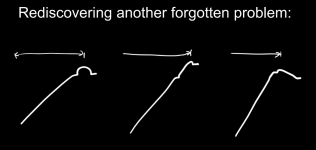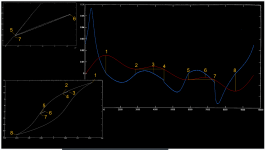The next AudioXpress will have a report from me about a presentation Bruno and Lars did for the NL AES section. That will have more technical details about the improvements in both the class D and the driver.
Jan
Purifi APS has a published US Patent Application [20190149920] which is entitled " A Method of Controlling Loudspeaker Diaphragm Excursion" ; inventors Putzeys and Risbo.
Any measurements, ether objective or subjective that you can show us?Yup, just like I have stated in the past that typical class D amplifier ferrite output inductors are noisy, I also stated that ferrite speaker magnets are noisy and I also stated that I have solution for this, ie Goop changes noise properties of such ferrites.
Dan.
Just scanning this patent this is about electronic driver excursion correction and not about driver design. Many Subwoofer do that is some form and Devialet has an DSP option to correct low frequency of many different loudspeakers called SAM (speaker aktive matching) which is apparently a feed forward implemented based on speaker measurements and not sensors like in many subwoofersPurifi APS has a published US Patent Application [20190149920] which is entitled " A Method of Controlling Loudspeaker Diaphragm Excursion" ; inventors Putzeys and Risbo.
could this be there is some 'electronic' correction applied to the speaker which enables this out of this world (-50db) thd levels ...? and the driver is ordinary except that...
idk if an amplifier can reduce the THD of sine waves... testings.
idk if an amplifier can reduce the THD of sine waves... testings.
Excursion control
Lots of history. Analog Bass Computer by DVR at KLH,many RH pro syztems, TI Smart Amp that Lars Risbo worked on and Klippel Controlled Sound among many others.
Lots of history. Analog Bass Computer by DVR at KLH,many RH pro syztems, TI Smart Amp that Lars Risbo worked on and Klippel Controlled Sound among many others.
this too :Not dissimilar to these Fostex FE108EΣ, which make a nice little workbench speaker or part of a bigger system. Good midband sound.

Lots of history. Analog Bass Computer by DVR at KLH,many RH pro syztems, TI Smart Amp that Lars Risbo worked on and Klippel Controlled Sound among many others.
ok , can such a system paired with a nominal -30db THD driver, give a 20db advantage in sweep tone testing, then becoming a -50 THD nominal driver hehe.
Stretching the surround (too far) causes distortion and I don't see how these designs really change that. But the surround has its own independent acoustic behavior (even at small to medium excursion), with resonances different from the membrane and I can envision that a more complex shape can ameliorate that by having multiple small resonances and thus reducing distortions caused by the surround. Are there any real data confirming that?
Hello Bill, no measurements, sorry about that. Only subjective experience, and conclusion that materials in contact with the ferrite ring or back plate/pole piece interact to some extent and alter sound properties.Any measurements, ether objective or subjective that you can show us?
Some drivers have for example plastic/foil fancy label (aftermarket car speakers especially) and removing this label changes the fundamental sound ime, ditto drivers with aluminium plate glued to rear of magnet assy.
I have an experimental putty/moulded formulation that when applied to typical magnet assemblies changes driver noise properties and when all drivers are so treated this magnet noise subjectively disappears and all drivers (both channels) merge into one sound source with unusual/unique clarity. You can experiment for yourself....try wrapping kitchen aluminium foil around the magnet assemblies of one channel and take a close listen, you ought to hear a different ASDR envelope that you may or may not prefer, I don't.
Cheers, Dan.
A subjective measurement is a measurement done with human ears. As opposed to objective measurements, witch are done with equipment.Subjective measurements?? 😱eek:
They can be very accurate, if you use the proper protocol, and that is a big if.
Infact subjective measurements are the basis of real progress in audio.
Thanks for the reply.Hello Bill, no measurements, sorry about <snip>
What is your protocol for subjective measurements?
Stretching the surround (too far) causes distortion and I don't see how these designs really change that. But the surround has its own independent acoustic behavior (even at small to medium excursion), with resonances different from the membrane and I can envision that a more complex shape can ameliorate that by having multiple small resonances and thus reducing distortions caused by the surround. Are there any real data confirming that?
What Risbo wanted to attack is the change in effective piston area with excursion due to shape change in the surround.
I have several graphs showing the improvement of the new driver to an 'industry standard' driver, but I don't know which improvement is due to the magnetic circuit changes or the surround changes.
Jan
Attachments
Only subjective experience, and conclusion that materials in contact with the ferrite ring or back plate/pole piece interact to some extent and alter sound properties.
I don't have a clue at the moment what could be the cause of this. But there is definitley some form of noise that can be caused by magnetic circuits like loudspeaker drivers or filter coils. It is called Barkhausen noise and it is caused by tiny jumps in the magnetisation curve. John Watkinson for instance claims that Speaker drivers with ferrite magnets wouldn't have an adequate SNR to make full use of the resolution given by 16 bit audio, let alone any of the hi-res formats. It could be possible that the Barkhausen effect is also a limiting factor in Class-D amps as soon as the rest of the amp is of very high quality. IIRC did the TacT Millennium amp use foil-wound air coils for the output filter. One would not only get rid of saturation effects this way but also the Barkhausen noise wouldn't be an issue. The downside are increased EMC issues.
Regards
Charles
You mean Subjective Assessment ?. Treating one loudspeaker and comparing to the other is the start. This can be one loudspeaker at a time or run both and listening around the room will discriminate differences. If a 'tweak' is determined effective the next step is to treat both speakers identically and listen to the system and live with the system. If a tweak is of effect this will be revealed quickly and extended exposure will reinforce findings. The key is to trust your ears but do not dismiss critiques from the kitchen.Thanks for the reply. What is your protocol for subjective measurements?
Dan.
Hi Jan
I would say, that the glitches at points 4 and 7 when the curves are returning from the small hysteris loops are caused by this effect.
Regards
Charles
I would say, that the glitches at points 4 and 7 when the curves are returning from the small hysteris loops are caused by this effect.
Regards
Charles
Hello Charles. Yes I am sure it is to do with Barkhausen noise and as another observation fitting clamp-on ferrite cable filters to line speaker or power cables causes 'gritty' distortion in typical systems. The aluminium foil/sheet will change damping of domain jumping cascade noises and in so doing impart a 'signature' or masking. There are different ferrite formulations so Watkinson may not be entirely correct, but I do know altering/controlling ferrite magnet noise ADSR by application of novel mixtures (think BQP) very nicely increases subjective resolution and delivers neutral and entirely non-fatiguing sound.I don't have a clue at the moment what could be the cause of this. But there is definitley some form of noise that can be caused by magnetic circuits like loudspeaker drivers or filter coils. It is called Barkhausen noise and it is caused by tiny jumps in the magnetisation curve. John Watkinson for instance claims that Speaker drivers with ferrite magnets wouldn't have an adequate SNR to make full use of the resolution given by 16 bit audio, let alone any of the hi-res formats. It could be possible that the Barkhausen effect is also a limiting factor in Class-D amps as soon as the rest of the amp is of very high quality.
Dan.
You mean Subjective Assessment ?. Treating one loudspeaker and comparing to the other is the start. This can be one loudspeaker at a time or run both and listening around the room will discriminate differences. If a 'tweak' is determined effective the next step is to treat both speakers identically and listen to the system and live with the system. If a tweak is of effect this will be revealed quickly and extended exposure will reinforce findings. The key is to trust your ears but do not dismiss critiques from the kitchen.
Dan.
I trust my ears, but I don't trust my mind. It's way to easy to fool yourself. That's why the protocol is so incredibly important. When testing, you are not allowed to know what's been tested when. This is the only way to prevent fooling yourself. Iow if you know your listening to the modified device, your brain will make assumptions not soly based on the input from your ears.
- Home
- Loudspeakers
- Multi-Way
- Purifi Audio by Bruno Putzeys and friends.

